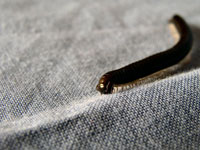Centipedes, Millipedes |
 Most species of centipedes and millipedes in temperate regions are not poisonous and do not cause damage to humans or their homes, but a centipede or millipede infestation can be really unpleasant for the people living in the house for psychological reasons, namely, that people are disgusted and frightened by them. Centipedes and millipedes may come in to a person's home because there is an infestation of other insects that the centipedes or millipedes feed on, or because the house has dark, moist areas and the centipedes or millipedes can get in from outside. To control an infestation of centipedes or millipedes, the underlying infestation of other insects may need to be treated, and moisture levels should be controlled, especially in damp areas of the house like basements. The most common type of centipede that infests homes is called, aptly, the house centipede. The house centipede, or Scutigera coleoptrata, originated from the Mediterranean region but has spread to other areas, including the United States and Canada. House centipedes eat other insects and spiders. When they are born, they only have eight legs. As they get older, they molt and grow up to thirty legs. All of these legs are fully detachable in case a predator attacks the centipede. A house centipede is typically one or two inches in length. The back legs and antennae look similar, making it difficult to tell which end of the centipede is the head end from a distance. The house centipede has eyes that are better developed than those of most other centipede species. House centipedes like to hide in basements, bathrooms, cabinets, garages, and firewood stockpiles. Other types of centipedes that live in houses may have anywhere from 30 to 382 legs, with one pair of legs attached to each body segment. Centipedes may live for several years. They are are nocturnal and feed during the night. House centipedes are not likely to bite, but some larger centipedes may bite when handled, causing a sharp pain. Millipedes have two pairs of legs attached to each body segment. Millipedes are not insectivores like centipedes; they mostly eat rotting organic matter and plant material. Millipedes are not capable of moving as quickly as centipedes, because they do not attack and kill live prey. The millipede species with the largest number of legs has 750 legs; no millipede has 1,000 legs. The legs of a millipede are much shorter than those of a centipede. Millipedes may destroy garden crops, but once they get into a house they are not as good at surviving as centipedes and they usually die off. Millipedes may be more likely to invade a home if there is a lot of rainfall outside. Millipedes also have a lifespan of five years or more. |
FREE QUOTE
Let's Get Started...
Save 20% By Scheduling Online...
Address
 Website Powered by BannerOS. Your Business Energized!
Website Powered by BannerOS. Your Business Energized!





